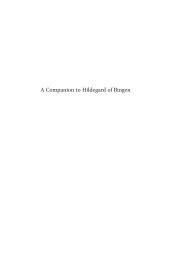Herinnering in geschrift en praktijk in religieuze gemeenschappen
You also want an ePaper? Increase the reach of your titles
YUMPU automatically turns print PDFs into web optimized ePapers that Google loves.
<strong>in</strong> the nam<strong>in</strong>g of a ‘motte de War<strong>en</strong>ne’ at Sa<strong>in</strong>t-Omer, exploit<strong>in</strong>g the wax<strong>in</strong>g and wan<strong>in</strong>g of<br />
Anglo-Flemish diplomacy around the turn of the c<strong>en</strong>tury. 16 The sudd<strong>en</strong>ness of the War<strong>en</strong>ne’s<br />
r<strong>en</strong>ewed pres<strong>en</strong>ce after an <strong>in</strong>terval of almost one hundred years is as <strong>in</strong>trigu<strong>in</strong>g as its dy<strong>in</strong>g days<br />
there before. What happ<strong>en</strong>ed <strong>in</strong> the <strong>in</strong>terval with regard to the monastery’s memory of its one<br />
time advocate family is a complete mystery. On the family’s side <strong>in</strong> the mid- twelfth-c<strong>en</strong>tury,<br />
however, the only h<strong>in</strong>ts of knowledge of its Flemish (but not Sa<strong>in</strong>t-Omer) past, is the passage<br />
<strong>in</strong> the War<strong>en</strong>ne Chronicle record<strong>in</strong>g William I’s bequest of lands <strong>in</strong> Flanders to his son<br />
Reg<strong>in</strong>ald and the refer<strong>en</strong>ce <strong>in</strong> Gundrada’s epitaph, writt<strong>en</strong> at the time of her death but carved<br />
afresh on her new tombstone, that she was a foreigner of ducal stock. 17 The evid<strong>en</strong>ce of<br />
the War<strong>en</strong>ne dossier suggests strongly that it is almost impossible to dist<strong>in</strong>guish betwe<strong>en</strong><br />
<strong>in</strong>stitutional and family contribution to memorial traditions. Seem<strong>in</strong>gly ext<strong>in</strong>ct memories<br />
of ancestors’ old rights, patronage and landhold<strong>in</strong>g, were on occasion revived, sometimes<br />
sudd<strong>en</strong>ly , to the b<strong>en</strong>efit of <strong>in</strong>stitution and dynasty provid<strong>in</strong>g evid<strong>en</strong>ce that memorial traditions<br />
are flexible constructs of artificial lives that can be put on hold as and wh<strong>en</strong> circumstances<br />
required.<br />
The thought of memorial tradition as an artificial construct with a life that allows for<br />
resurrection after appar<strong>en</strong>t death, discussed thus far <strong>in</strong> vocabulary derived from the life cycle,<br />
poses an <strong>in</strong>terest<strong>in</strong>g paradox. The lifecycle of man from birth to death is a biological process<br />
that by def<strong>in</strong>ition is f<strong>in</strong>ite. The Christian faith, and others as well, provide spiritual consolation<br />
<strong>in</strong> its belief that biological life, that on earth, is just a preparation for the life that really matters:<br />
eternal life after death. Aga<strong>in</strong>st the background of this belief structure, medieval man clearly<br />
had no problems with the birth and death and rebirth of traditions. On average collective<br />
memory lasted three or four g<strong>en</strong>erations, or at least was considered to be able to produce valid<br />
testimonies provided the witness could recall a cha<strong>in</strong> of memories go<strong>in</strong>g back to a (great)<br />
grandfather (ev<strong>en</strong> if the (great) grandson had never personally known him). Thereafter a new<br />
cha<strong>in</strong> would beg<strong>in</strong>. 18<br />
The chronology of collective memory was, therefore, a process organised by the biology of<br />
the lifecycle. Three to four g<strong>en</strong>erations cover<strong>in</strong>g a period dur<strong>in</strong>g which members of a family<br />
could biologically have met and talked and exchanged memories of past ev<strong>en</strong>ts. Each life, from<br />
birth to death, is a concat<strong>en</strong>ation of ev<strong>en</strong>ts that carries emotions with it. 19 Birth equates with joy<br />
and death with grief. H<strong>en</strong>ce the life cycle vocabulary for death (or birth for that matter) is tied<br />
16<br />
Van Houts, ‘The War<strong>en</strong>ne View of the Past, 1066-1203’, 115-19. The first charter <strong>in</strong> which Hamel<strong>in</strong> occurs can<br />
be found <strong>in</strong> Les chartes de Sa<strong>in</strong>t-Bert<strong>in</strong>, ed. Haigneré, vol. I, no. 325, where on p. 114 it is dated to c. 1182; the<br />
‘motte de War<strong>en</strong>ne’ is m<strong>en</strong>tioned <strong>in</strong> A. Derville, Sa<strong>in</strong>t-Omer des orig<strong>in</strong>s au début du XIVe siècle (Lille, 1995),<br />
p. 37.<br />
17<br />
+ STIRPS GUNDRADA . DVCV (M) DEC (VS) EVI . NOBILE GERMEN:/ INTVLIT ECCLESIIS<br />
ANGLORV (M) BALSAMA MORV (M): ¨Gundrada, offspr<strong>in</strong>g of dukes, glory of the age, noble shoot / brought<br />
to the churches of the English the balm of her character ‘(Gundrada’s epitaph, first two l<strong>in</strong>es). The passage on the<br />
division of the <strong>in</strong>heritance can be found <strong>in</strong> The War<strong>en</strong>ne Chronicle, ed. van Houts and Love, par. 17 (Hyde<br />
Chronicle, ed. Edwards, p. 299): ‘Willelmus autem de War<strong>en</strong>nia apud obsidionem Peu<strong>en</strong>eselli sagitta <strong>in</strong> crure<br />
ualde uulneratus Leuwias cum omnium merore deportatus est. Cumque sibi mortem imm<strong>in</strong>ere uideret duos filios<br />
suos iuxta regis decretum heredes fecit, Willelmum uidelicet <strong>in</strong> Anglia et Reg<strong>in</strong>aldum <strong>in</strong> Flandria, et sic <strong>in</strong> pace<br />
quieuit <strong>in</strong> Dom<strong>in</strong>o’.<br />
18<br />
On lifecycle and memory, see E.van Houts, Memory and G<strong>en</strong>der <strong>in</strong> Medieval Europe, 900-1200 (Bas<strong>in</strong>gstoke:<br />
Macmillan, 1999), pp. 27-28.<br />
19<br />
For a rec<strong>en</strong>t exploration of the history of emotions, especially <strong>in</strong> the Middle ages, see the debate on this subject<br />
<strong>in</strong> Early Medieval Europe 10 (2001), pp. 225-27 (C. Cubitt, ‘The History of Emotions: A Debate: Introduction’),<br />
pp. 229-41 (B. H. Ros<strong>en</strong>we<strong>in</strong>, ‘Writ<strong>in</strong>g without Fear about Early Medieval Emotions’), pp. 243-50 (M. Garrison,<br />
‘The Study of Emotions <strong>in</strong> Early Medieval History: Some Start<strong>in</strong>g Po<strong>in</strong>ts’), pp. 251-56 (C. Larr<strong>in</strong>gton, ‘The<br />
Psychology of Emotion and Study of the Medieval World’).<br />
33
















